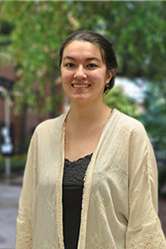Biochemistry and Molecular Biology
“Study of Binding Affinity of Crotamine-Au-Nanoparticles with DNA”
Crotamine is a toxin that is present in the venom of Crotalus durissus terrificus, the South American rattlesnake found in Brazil and has been shown to have a preference for targeting rapidly proliferating cells, such as malignant cancer cells, and displays numerous other functions, including DNA delivery and localization to the nucleus upon penetrating the cell. Thus, crotamine is an attractive candidate to be used as an instrument in a drug delivery or multifunctional system. Linking crotamine to a gold (Au) nanoparticle will enable crotamine to become part of a multifunctional system, which has been the long term goal of the studies on crotamine. Determining the binding affinity of crotamine-PEG-GNP to heparin and DNA is the first step in the long process of determining how effective the crotamine-PEG-GNP will be as a multifunctional system. Previous experiments have been performed to determine the binding activity of free crotamine to heparin and DNA using the cationic dye, azure A, which is a competitive assay. To obtain data on crotamine-PEG-GNP’s binding activity, the same assay will be performed with the exception being that crotamine-PEG-GNPs will be used rather than free crotamine. This will allow results to be compared. The crotamine-Au-nanoparticles that will be used in this experiment have already been produced, but the properties of crotamine, particularly that of binding affinity, when linked to PEG-GNP, have yet to be observed. Therefore, this project will aim to study the binding of crotamine-PEG-GNP to heparin, a highly sulfated carbohydrate chain that is similar to heparin sulfate proteoglycans present in cell membranes, and DNA. Studying the binding affinity of the crotamine-PEG-GNP for heparin and DNA will help to determine if the GNP will possess the properties of crotamine that have been observed using free crotamine and whether it will make a good multifunctional system that can be utilized in drug delivery.
Who is your mentor for your research project? How did you arrange to work with this person?
My mentor is Dr. Richard Karpel from the Biochemistry and Chemistry Department. During an advising meeting with Dr. Karpel, I spoke to him about his research. His work with the protein crotamine was interesting to me, so I scheduled a separate meeting with him that was specifically about the research performed in his lab. After a few meetings, I was offered a position in his lab. Sometimes, just expressing an interest in something can open doors into opportunities you might never even dream of.
How did you know this was the project you wanted to do?
I have always been interested in working with DNA and possible methods of curing cancer. My project, entitled “Study of Binding Affinity of Crotamine-Au-Nanoparticles with DNA”, includes both of my interests by aiming to study the binding of crotamine-Au-nanoparticles to heparin and DNA to determine if the gold-nanoparticles possess the properties of crotamine that have been observed using free crotamine and whether it will make a good multifunctional system that can be utilized in drug delivery. It is part of a larger study that hopes to utilize crotamine as a cancer drug delivery agent.
Is this your first independent research project?
Yes, this is my first independent research project, though I have been working in Dr. Karpel’s lab for the past year.
What academic background did you have before you applied for the URA?
When I applied for the URA, I had completed three years of biology and chemistry courses (both lecture and labs), and one semester of biochemistry.
Was the application difficult to do? How much did your mentor help you with the application?
No, not at all. Once I came up with the project and methods, writing the proposal was straight forward. I wrote the proposal on my own and then ran the draft by my mentor. Together, we finalized the application that I turned in.
What else are you involved in on campus?
As a premed student, I attend Pre-Med Society meetings. I am also a TA for Biology 142: Evolution and Ecology. I was also a Woolie for the new students on 1st South floor in Susquehanna Hall during Welcome Week 2015 in August.
What is your advice to other students about getting involved in research?
Make the most of every opportunity. It’s always best to be actively seeking a research position or internship, but if something falls into your lap and interests you, go for it! The opportunity might not come again. Even if you don’t plan to make a career out of research, it will be a chance to try something new and expand your horizons (and it will also look great on your resume!). The best part about research is that it’s hands-on, so you don’t just talk about theory, you actually put it use.
What are your career goals?
Once I graduate with my Bachelors of Science in Biochemistry and Molecular Biology, I plan to pursue an MD (hopefully, at University of Maryland School of Medicine) and would like to specialize in oncology. The field of oncology would allow me to be able to have the opportunity to treat patients and promote health wellness and prevention within the community while also opening the door for me to do research on genetic diseases and to continue studying how mutations of genes found in DNA can cause and affect cancer.
8/27/2015
